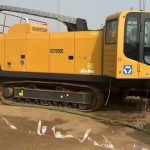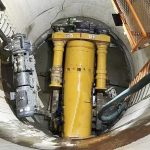Categories
Latest Updates





Some common fault handling table of hydraulic system
| Failure phenomenon | Cause of issue | Method of exclusion |
| Under pressure | 1. The pressure gauge is damaged | Replace the pressure gauge |
| 2. The pump speed is too low | Check the diesel engine | |
| 3. Internal leakage of actuator | Replace the seal of the actuator or replace the new actuator (cylinder or hydraulic motor) | |
| 4. The oil pump is damaged | Repair or replace the oil pump | |
| 5. Oil pipe leakage | Check and replace the oil pipe | |
| 6. Improper pressure adjustment | Re-adjust the pressure | |
| 7. Insufficient hydraulic oil | Fill hydraulic oil | |
| 8. The system oil temperature is too high and the leakage is too large | Cooling hydraulic oil | |
| The actuator speed is too slow (hydraulic cylinder or hydraulic motor) | 1. Internal leakage of actuator | Replace the seal of the actuator or replace the new actuator (cylinder or hydraulic motor) |
| 2. Oil pump leakage | Repair or replace the oil pump | |
| 3. The one-way valve in the oil circuit fails, causing oil leakage | Repair or replace the one-way valve | |
| 4. The solenoid valve fails, and the valve is not fully opened | Clean or replace the solenoid valve | |
| 5. Excessive load | Reduce the load | |
| 6. Improper adjustment of overflow valve | Re-adjust the overflow | |
| 7. The variable mechanism of the oil pump fails, and the flow cannot be increased | Check the oil pump and repair or replace | |
| 8. Insufficient hydraulic oil | Fill hydraulic oil | |
| 9. The system oil temperature is too high and the leakage is too large | Cooling hydraulic oil | |
| 10. The filter element is blocked | Check and clean all filter elements | |
| System oil temperature is too high | 1. The pressure of the relief valve is too high | Properly adjust the pressure of the relief valve |
| 2. Too little hydraulic oil | Fill hydraulic oil | |
| 3. Leakage in system executive components | Repair or replace internal leakage components | |
| 4. The system heat sink is damaged | Repair the heat sink |
Common fault handling table for electrical parts
| Failure phenomenon | Cause of issue | Method of exclusion |
| The battery cannot be charged | 1. The generator burns out | Replace or repair generator |
| 2. The electronic regulator is burned out | Replace the regulator | |
| 3. The battery is damaged | Replace or repair the battery | |
| 4. Poor wiring | Reconnect the wires | |
| Electrical appliances have no related operating actions | 1. The operation button or handle is damaged | Replace related buttons or knobs |
| 2. Poor wiring | Check and re-wire | |
| 3. Relay ablation | Replace the relay | |
| 4. The solenoid valve coil or relay coil is burnt out | Check and replace the relevant coil | |
| 5. The solenoid valve is stuck | Clean the solenoid valve | |
| 6. The battery is dead | Charge the battery | |
| 7. The emergency button is pressed or the power switch is not closed | Pull out the emergency button or switch on the power switch after handling the relevant incident | |
| 8. The voltage regulator tube or switching power supply is damaged | Replace related accessories | |
| 9. The fuse is burned out | Replace the fuse |
Some common fault handling table of reducer
| Failure phenomenon | Cause of issue | Method of exclusion |
| Reducer overheating | 1) Overload | 1) Check the actual load, adjust to the specified value or replace with a larger power reducer |
| 2) Insufficient or excessive lubricating oil | 2) Use oil in accordance with the prescribed amount of oil | |
| Abnormal and stable running noise | 1) Rotation/grinding noise, bearing damage | 1) Check the oil |
| 2) Knocking noise, irregular meshing | 2) Contact the user service organization | |
| Abnormal and unstable running noise | Oil pollution or insufficient oil | Change the oil or refuel to the specified value |
| Oil spill | Seal damage | Contact the user service agency |
| The output shaft does not rotate when the motor is rotating | The reducer motor is damaged | Send for repair or replacement |
Troubleshooting table for common faults in the push-pull part of the power head
| Failure phenomenon | Cause of issue | Method of exclusion |
| Weak push and pull | 1. Motor internal leakage | Repair or replace the motor |
| 2. The overflow valve of the proportional multi-way valve is stuck | Repair or replace the overflow valve | |
| 3. Push-pull speed is too slow | Refer to the solution for too slow rotation speed | |
| No push-pull action | 1. Motor is damaged | Repair or replace the motor |
| 2. The handle is damaged | Repair or replace the handle | |
| 3. The oil pump is damaged | Replace the oil pump | |
| 4. The oil pump is damaged | Replace the oil pump | |
| Abnormal sound of gearbox | 1. Gearbox is out of oil | After replacing the damaged parts, add oil |
| 2. Bearing damage | Replace damaged bearings | |
| Oil leakage in the gearbox | 1. The paper pad where the motor is installed is damaged or not installed properly | Replace the paper pad |
| 2. The oil seals or gaskets at both ends of the spindle output are worn or not installed | Replace the oil seal |
Common troubleshooting table for rotating part of power head
| Failure phenomenon | Cause of issue | Method of exclusion |
| Weak rotation | 1. Internal leakage of electro-hydraulic valve | Repair or replace the electro-hydraulic valve |
| 2. The oil pump is damaged | Repair or replace the oil pump | |
| 3. Internal leakage of hydraulic motor | Repair or replace the motor | |
| 4. The system oil temperature is too high | Reduce oil temperature | |
| 5. The system is short of oil | Add hydraulic oil | |
| Rotation speed is too slow | 1. Excessive load | Reduce the load |
| 2. Low system pressure | Increase system pressure | |
| Rotation speed is too slow | 3. The electro-hydraulic valve is stuck | Clean the electro-hydraulic valve |
| 4. Insufficient oil supply from the oil pump | Repair or replace the oil pump | |
| 5. Motor internal leakage | Repair or replace the motor | |
| No rotation | 1. The closed pump is damaged or the closed pump coil is burned out | Repair or replace closed pumps or coils |
| 2. The handle is damaged | Repair or replace the handle | |
| 3. Motor damage | Repair or replace the motor |
Common troubleshooting table for clamping part
| Failure phenomenon | Cause of issue | Method of exclusion |
| Weak clamping | 1. The clamping multi-way valve is blocked | Cleaning the clamping multi-way valve |
| 2. The clip strip is severely worn | Replace the clip strip | |
| 3. Internal leakage of clamping hydraulic lock | Replace or repair the hydraulic lock | |
| 4. Internal leakage of the clamping oil cylinder | Repair the clamping cylinder and replace related seals |
Walking part (caterpillar) common troubleshooting table
| Failure phenomenon | Cause of issue | Method of exclusion |
| Walking weakness | 1. Internal leakage of walking motor | Repair or replace the walking motor |
| 2. The pressure of the walking system is not adjusted enough | Re-adjust the pressure | |
| 3. Leakage inside the oil pump | Repair or replace the oil pump | |
| 4. The overflow valve is blocked or damaged | Clean or replace the overflow valve | |
| 5. Slack track | Re-adjust the track tensioning mechanism | |
| The track is off the chain | 1. Insufficient tension | Re-adjust the tensioning mechanism |
| 2. The track shoe is broken | Replace the track shoe | |
| 3. The chain track is cracked | Replace the chain track |
Common fault handling table of mud pump
| Failure phenomenon | Cause of issue | Method of exclusion |
| Mud pump does not deliver water | 1. Air enters the mud pump | Exhaust treatment |
| 2. No water source enters the mud pump | The water tank is filled with water, the water valve is opened, and the water inlet is unblocked; | |
| 3. The mud pump does not rotate | Check whether the mud pump drive motor is working normally, whether the hydraulic pipeline is under pressure, and whether the solenoid valve is working; | |
| 4. The mud pump pressure is too low (water pressure) | The mud pump cylinder sleeve wears out and needs to be replaced; the water source has many impurities, and the inlet and outlet valve seats of the pump head should be disassembled and cleaned; | |
| 5. The mud pump check valve seat is worn or the steel ball is out of round | Replace related accessories | |
| The mud pump can’t reach the displacement or can’t discharge the medium at all | 1. The filter comes out of the water | Make the filter immerse into the liquid surface, the depth is not less than 0.3~0.5m |
| 2. The filter is blocked | Take out the filter for cleaning | |
| 3. The suction pipe is blocked | Disassemble and clean the suction pipe | |
| 4. The suction pipe is not tightly sealed to inhale air | Check the connections and hoses and try to eliminate them | |
| 5. The inlet and outlet valves are stuck and do not work | Replace the parts due to the valve or valve seat being worn and stuck; due to the clogging of sediment, the bottom of the pump head and the cylinder liner can be opened for cleaning; | |
| 6. Piston or cylinder liner wear | Open the cylinder head, tighten the copper screw sleeve pressing the piston or replace the piston or cylinder liner; | |
| 7. The suction channel is not filled with water or air pockets are formed | Fill with water and exhaust air (a water filling funnel can be installed for filling and exhausting) | |
| 8. The water absorption height exceeds the allowable height | Adjust the water absorption height to within 2.5m (for thick mud, drop to within 1m) | |
| 9. The suction pipe is too long or the diameter is too small | Reduce the length to less than 5m; increase the pipe diameter to the specified size | |
| 10. Insufficient oil supply or insufficient pressure of the oil pump, reducing the speed and torque of the motor; | Check and exclude | |
| Difficulty in operation of mud pump | 1. The filter comes out of the water | Loosen the adjusting screw sleeve to reduce the interference of the sealing ring |
| 2. The filter is blocked | Check the gap and adjust | |
| 3. The suction pipe is blocked | Check and eliminate | |
| 4. The suction pipe is not tightly sealed to inhale air | Check and tighten | |
| There is a strange sound during operation | 5. The inlet and outlet valves are stuck and do not work | Adjust the bearing gap or replace with a new bearing |
| 6. Piston or cylinder liner wear | Check and tighten | |
| 7. The suction channel is not filled with water or air pockets are formed | Check and replace damaged parts | |
| 8. The water absorption height exceeds the allowable height | Check and adjust the adjustment bolts on the shaft end cover | |
| Excessive pressure pulsation | 1. The through hole on the head of the pressure gauge is blocked | Cleaning the through hole on the head of the pressure gauge |
| 2. The piston of a cylinder is severely worn | Check and replace new parts | |
| 3. The valve seat or valve seat hole of a cylinder is severely worn | Check and replace new parts or repair valve seat holes | |
| 4. The valve seat of a certain cylinder is stuck by impurities and cannot work | Check and clear | |
| 5. The clearance between the valve seat and the valve seat hole is too large | Eliminate the gap | |
| 6. The discharge medium contains a lot of gas | Check the cause and eliminate | |
| 7. The pressure gauge is damaged | Replace the new pressure gauge | |
| Local fever or excessive temperature rise | 1. There is too much lubricating oil in the crankcase, which greatly exceeds the specified liquid level | Check and drain the oil to the specified height |
| 2. The connecting rod bearing bush is assembled too tightly, and the clearance of the three tapered bearings is too small | Check and adjust to a reasonable gap | |
| 3. The piston seal assembly is too tight | Adjust the tightness of the seal | |
| Shift gears out of gear | 1. After the gear is engaged, the top adjusting bolt is not tight, and the positioning steel ball on the shift lever is pressed | Check and tighten the top adjustment bolt until it stops |
| 2. The set screws on the shift fork and the shift guide rod are not tightly pressed | Check and tighten the set screws, add iron wire to prevent loosening | |
| The safety valve and the unloading valve are leaking, and the safety valve is malfunctioning | 1. The pre-pressure of the compression spring in the safety valve is insufficient | Adjust the spring pressure; |
| 2. The end surface of the valve seat is not flat and the inner hole is not round | Inspect and repair; | |
| 3. There is debris in the contact between the valve and the valve seat | Check and clean; | |
| 4. Compression spring is crushed | Re-adjust the looseness to ensure the spring margin |
